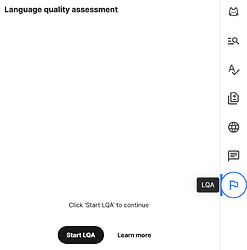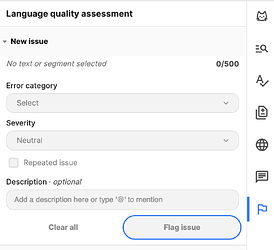.
Language Quality Inspection in Phrase TMS - Instructions
Introduction
A Language Quality Inspection consists of an analysis of a source text and its translation to record and classify any issues using an error typology. The result is a score that is used to inform the quality management process.
We can perform this task when we suspect there are quality issues on a file or following our partner’s feedback. Sometimes our Partner can just provide general feedback and some other times they can provide us with a revised file with comments or track changes.
In case the Partner provides us with a commented/revised file, we would need you to analyze these changes and also implement them in Phrase TMS so our Translation Memories and final files are up-to-date. Indeed, it is very important to keep a record of these changes so future translations are aligned with our Partner’s expectations. Such reviews can also help us see if we need to update/revise our Glossary or even create a specific style guide. These reviews help us guarantee consistency between translations and also help us improve in future work.
In case you need support during this task, please make sure to reach out to your Project Officer who will advise you. You can reach them by email.
Evaluate translation quality
To assess the quality of its translations, TWB uses an adapted version of the harmonized DQF-MQM error typology. This is a translation industry standard based on TAUS’s Dynamic Quality Framework and the EU’s Multidimensional Quality Metrics. These two standards were developed separately, but they were harmonized into one general standard that we use today.
Below are the main categories we work with, which you can read more about here.
![]() Accuracy: Ensure the translation communicates the meaning of the original text correctly and precisely. Examples:
Accuracy: Ensure the translation communicates the meaning of the original text correctly and precisely. Examples:
- Addition or omission
- Mistranslation
- Under-translation or over-translation
![]() Fluency: Issues related to the form or content of a text, irrespective of whether it is a translation or not. Examples:
Fluency: Issues related to the form or content of a text, irrespective of whether it is a translation or not. Examples:
- Punctuation
- Spelling
- Grammar
- Inconsistencies
![]() Style: Create a translation that sounds idiomatic (natural) when you read it and is appropriate for the readers. Examples:
Style: Create a translation that sounds idiomatic (natural) when you read it and is appropriate for the readers. Examples:
- Awkward
- Inconsistent
- Unidiomatic
![]() Terminology: Look at whether or not the keywords and phrases are translated accurately and if the same translation is used for each term throughout the text.
Terminology: Look at whether or not the keywords and phrases are translated accurately and if the same translation is used for each term throughout the text.
![]() Design: Whether or not the translation is formatted properly. Does the document contain easy to read and follow tables, images, or other visual elements?
Design: Whether or not the translation is formatted properly. Does the document contain easy to read and follow tables, images, or other visual elements?
Please, consult this thread in our forum to learn more about each category
Also note that there are additional factors that may impact the perceived quality of the translation:
- the quality of the source document
- the formatting of the source files
- the volume of content
- the complexity
- tight turnaround times
Feel free to add any other comments/suggestions and to flag it if you disagree with a change.
Quality assessment of a Translation in Phrase TMS
Instructions
If you have any questions about the instructions provided or need anything, please do not hesitate to contact your Project Officer. They will be happy to help out!
Important: For all tasks, please make sure to read this post on How to Provide Constructive and Respectful Feedback
Request
You will receive the documentation below to help you perform this task:
- The source file
- The translation
- LQA Task link: The Project Officer who contacted you will also assign you an LQA Task on Phrase TMS, so please make sure that you are assigned and can access the LQA Task link.
- Language Style guide
- Glossary
Process
Phrase TMS LQA functionality calculates a PASS/FAIL score based on all segments/word count in a given job, therefore all segments in a job must be evaluated for the score to be calculated correctly.
To add an assessment, follow these steps:
- Select the LQA tab from the right-click menu and click Start LQA.
- Select a segment.
To assess a particular piece of text, select the text inside the segment.
- Click the flag icon next to the segment:
or select Flag issue from the right-click menu:
The LQA tab opens and the selected text is highlighted within the segment.
- Select an Error Category, Severity, if the issue is a repeated one and an optional description.
- Click Flag issue.
Repeat this step to add more assessments.
LQA assessment is added and can be edited, replied to, or deleted from the menu.
Assessments are added to the LQA tab.
- Segments with LQA assessments are identified with a solid flag icon.
- When one, Click “Finish”.
You can find here more information for this task in this Phrase TMS Help article.
Pre-delivery checklist
![]() Do I have all the materials needed for this task?
Do I have all the materials needed for this task?
![]() Have I confirmed any doubts with the Project Officer?
Have I confirmed any doubts with the Project Officer?
![]() Have I reviewed all changes/suggestions/revisions?
Have I reviewed all changes/suggestions/revisions?
![]() Have I marked all segments with errors with a Flag?
Have I marked all segments with errors with a Flag?
![]() Have I clicked “Save LQA” on Phrase TMS?
Have I clicked “Save LQA” on Phrase TMS?
![]() Have I run a spell check?
Have I run a spell check?
![]() Once you are done, mark the LQA task completed on Phrase TMS and let the Project Officer know that the task is completed.
Once you are done, mark the LQA task completed on Phrase TMS and let the Project Officer know that the task is completed.



